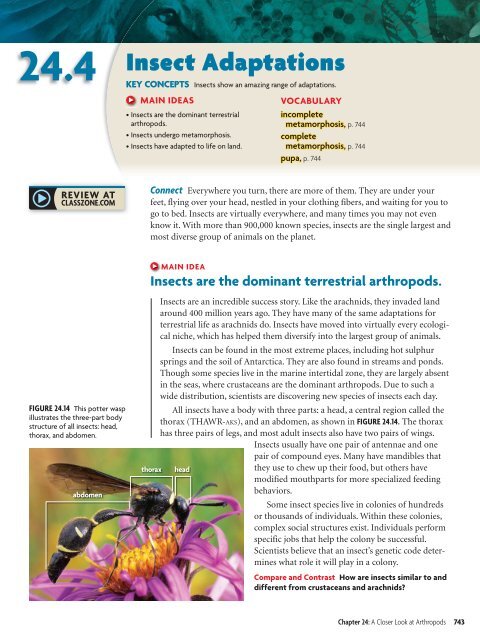24 A Closer Look at Arthropods
24 A Closer Look at Arthropods
24 A Closer Look at Arthropods
You also want an ePaper? Increase the reach of your titles
YUMPU automatically turns print PDFs into web optimized ePapers that Google loves.
<strong>24</strong>.4<br />
Insect Adapt<strong>at</strong>ions<br />
KEY CONCEPTS Insects show an amazing range of adapt<strong>at</strong>ions.<br />
MAIN IDEAS<br />
• Insects are the dominant terrestrial<br />
arthropods.<br />
• Insects undergo metamorphosis.<br />
• Insects have adapted to life on land.<br />
VOCABULARY<br />
incomplete<br />
metamorphosis, p. 744<br />
complete<br />
metamorphosis, p. 744<br />
pupa, p. 744<br />
Connect Everywhere you turn, there are more of them. They are under your<br />
feet, flying over your head, nestled in your clothing fibers, and waiting for you to<br />
go to bed. Insects are virtually everywhere, and many times you may not even<br />
know it. With more than 900,000 known species, insects are the single largest and<br />
most diverse group of animals on the planet.<br />
FIGURE <strong>24</strong>.14 This potter wasp<br />
illustr<strong>at</strong>es the three-part body<br />
structure of all insects: head,<br />
thorax, and abdomen.<br />
abdomen<br />
MAIN IDEA<br />
Insects are the dominant terrestrial arthropods.<br />
Insects are an incredible success story. Like the arachnids, they invaded land<br />
around 400 million years ago. They have many of the same adapt<strong>at</strong>ions for<br />
terrestrial life as arachnids do. Insects have moved into virtually every ecological<br />
niche, which has helped them diversify into the largest group of animals.<br />
Insects can be found in the most extreme places, including hot sulphur<br />
springs and the soil of Antarctica. They are also found in streams and ponds.<br />
Though some species live in the marine intertidal zone, they are largely absent<br />
in the seas, where crustaceans are the dominant arthropods. Due to such a<br />
wide distribution, scientists are discovering new species of insects each day.<br />
All insects have a body with three parts: a head, a central region called the<br />
thorax (THAWR-AKS), and an abdomen, as shown in FIGURE <strong>24</strong>.14. The thorax<br />
has three pairs of legs, and most adult insects also have two pairs of wings.<br />
Insects usually have one pair of antennae and one<br />
pair of compound eyes. Many have mandibles th<strong>at</strong><br />
thorax head<br />
they use to chew up their food, but others have<br />
modified mouthparts for more specialized feeding<br />
behaviors.<br />
Some insect species live in colonies of hundreds<br />
or thousands of individuals. Within these colonies,<br />
complex social structures exist. Individuals perform<br />
specific jobs th<strong>at</strong> help the colony be successful.<br />
Scientists believe th<strong>at</strong> an insect’s genetic code determines<br />
wh<strong>at</strong> role it will play in a colony.<br />
Compare and Contrast How are insects similar to and<br />
different from crustaceans and arachnids?<br />
Chapter <strong>24</strong>: A <strong>Closer</strong> <strong>Look</strong> <strong>at</strong> <strong>Arthropods</strong> 743

















